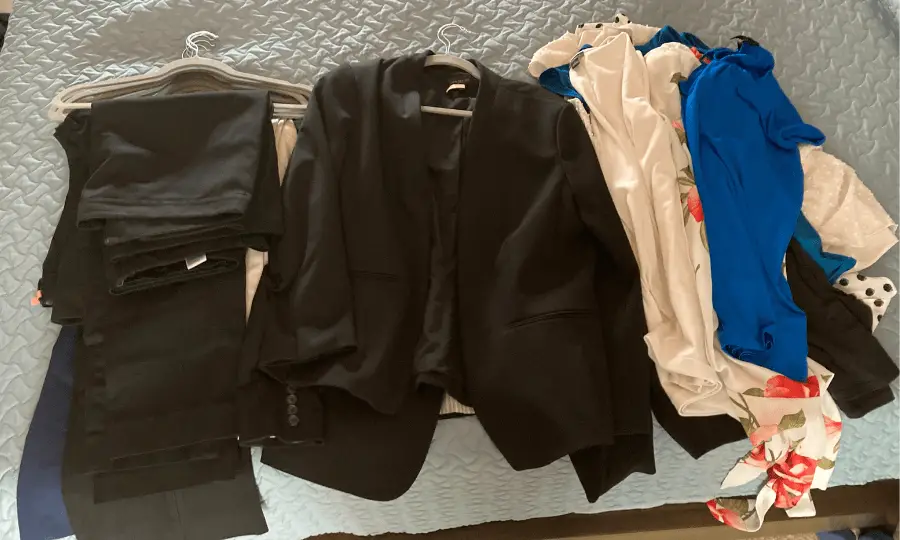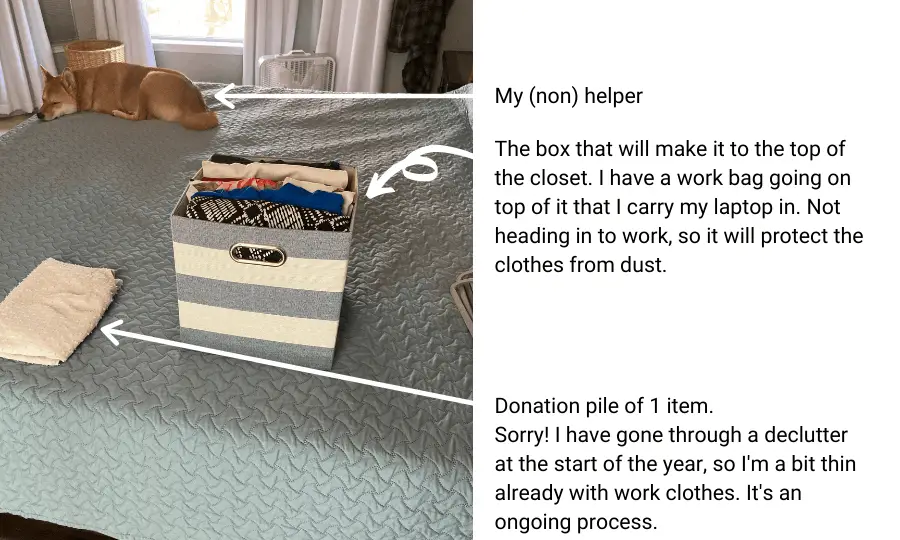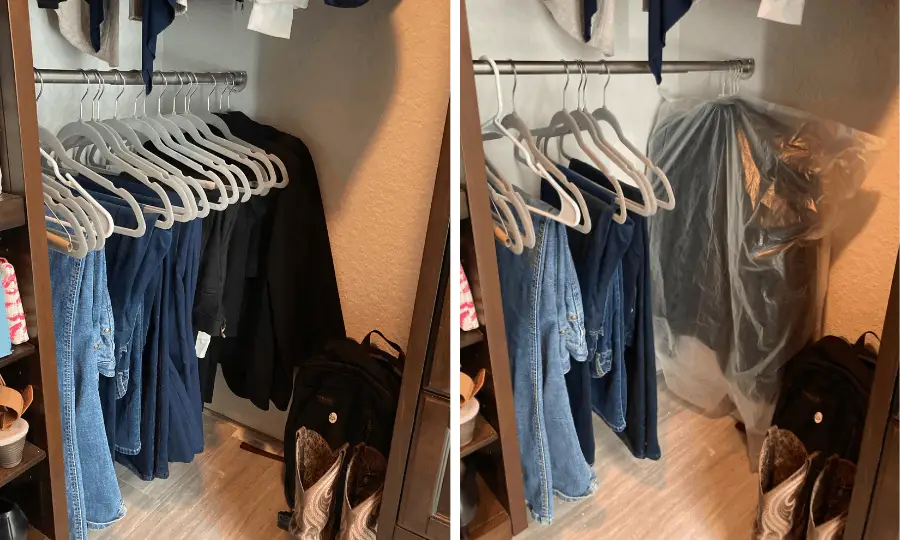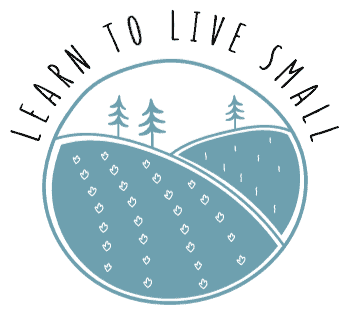Many people have had an overnight shift to working from home due to the pandemic. I am one of those people, but the company I work for continues to tell us that we will be back in the office as soon as possible. We are now 8 months into working from home, though. My work clothes are literally gathering dust. It is completely irritating to need to dust or wash clothes that aren’t being used, but I know I will need them at some point in the near future.
I do hope that I am able to convince my employer to let me work from home in a more permanent solution, but in the meanwhile, I need a solution that keeps only the clothes I’m wearing at the forefront and doesn’t require me to literally dust my clothes.
When decluttering I hope to reduce my overall positions. After all, I hope to end up in a much smaller house. For now, I’ll get these items out of the way instead.
Before diving in, be sure to set enough time aside to go through each item and handle each item as you are going through this process. If you have clothes that you would like to sell instead of donating, then be prepared to photograph and list them while you are going through this process. Make it a one-touch and done task!
Why Declutter Since I’ll Need The Clothes Later?
I do not like to see more than I actually use in my drawers. Each item is a decision point, and minimizing decisions and clutter is important to me. Ideally, I’d declutter to get rid of an item, but I know that going back into the office is in my future. Whether that is 1 month or 1 year, I just do not know at the moment.
I also do not care to store items either. The sudden shift to work from home could lead me back to the office just as suddenly, so I am making an exception about storing clothes. This whole time is crazy, so we can all give ourselves some grace!
So I find myself stuck between my need to keep things organized and decluttered while also not departing with my entire work wardrobe.
However, when I saw a layer of dust on all of my dark work pants and skirts hanging in my closet, I knew I couldn’t just put this off in hopes of going back soon.
I am NOT going to dust my pants or add to laundry unnecessarily.
Tips to Minimize Work Clothes (During a Pandemic or Other Temporary Event)
1. Assess what you actually wear day-to-day
If you have hit the point that you’re ready to declutter because of the pandemic or some other temporary shift to working from home, you already have a sense of what you’re wearing from day-to-day.
I am personally on ZERO video conferences, but I still try to dress like I am going to work as part of a weight-loss strategy. Even still, I am not wearing all of the clothes I normally did when I physically went to work. If you are wearing sweats daily, you may find that your work clothes do not fit you, so take heed here. I’m sitting here with the COVID-10 pounds at the moment myself.
This step can be a physical assessment or a mental. Either way, it’s time to grab all of the items you haven’t actually worn or would prefer not to when you head back to the office.
2. For every item you do not wear while working from home, take it to 1 location
Every item that you aren’t wearing should be taken to a central spot to go through. I used my bed as the collection and sorting spot.
Now go back to where you keep your work clothes and think through the items again. You aren’t committing to getting rid of anything necessarily. You’re just minimizing the clothing and the decisions you have to make each day of the current work situation.

3. Now decide on what to keep
Since you are in the mental space to think about what to do with your work clothing, actually think about what you would and would not like to wear when it is time to go back into the office.
I do not recommend getting rid of everything! I would hate what it would do to my budget and sanity when I am required to go back to the office from a last-minute notification from my boss if I had to replace a whole wardrobe.
Go through the pile one item at a time. Physically pick each item up, look at it objectively, and then you can decide if it is an item you can see yourself wearing when it is time to go into the office.
You are welcome to try something on if you feel like it would help you make a decision on the item.
Form 2 piles. You’ll want a Keep pile and a Donate or Sell pile. I will be donating what I do not want to keep to help someone else fill their work wardrobe and to give me the instant gratification of the declutter/storing.
If you struggle with the idea that you spent your hard-earned money on these clothes, so you hesitate to get rid of them, thank the item for the value it gave you when you enjoyed wearing it first and then decide.
Also, if you feel strongly about keeping an item, by all means, do so! The point of this exercise is really to care for the items better by storing them with a dose of thinking through whether you really need the items at all.
4. Fold and put away the items you are keeping in storage
Now you simply fold the clothing you are planning to keep but store. I generally fold like I learned through going through Kon-Mari videos. Yes, I am storing them, but I like the idea of taking care of them by neatly interacting with each item. Plus, this method tends to minimize too many wrinkles since you’re storing them, after all.
I am storing my clothes in a box at the top of my closet. I keep a step ladder in my closet, so they are quick to grab and reintegrate into my closet when I am headed back to the office from here.
Check out a video with Marie Condo here if you are interested in learning more about how she folds clothes.
5. Organize what you’re selling or donating
Donations
I also neatly fold the clothing I am donating. I do not fully fold in the same way I do the clothes I am keeping as they are going to be sorted through wherever the donations are handled. However, I still like to take care of them, and folding the clothing allows them to condense well for the box or bag I use for the donation.
Before you call this section done, take a walk-through of your drawers and closet again, as well as, your accessories such as scarves or fashion jewelry.
Go ahead and put your donations into the back of your car right now to avoid putting it off.

Items to Sale
If you are selling anything, while you have the item out, photograph and list the item NOW. Sitting on the item adds to your mental clutter, so you will be much happier in the long run by handling this as part of the process to declutter. Since you are going back to work at some point, it should only be a handful of items to knock out.
6. Put away what you are keeping
I hung the blazers back in the closet but with a plastic garbage bag over them with the hanger poking out. I do not want to have them sent to dry cleaning, but I want to keep the dust at bay.
The items in the box went up to the top of my closet.
7. Admire the minimized impact to your closet and drawers.
Your drawers, shelves, and hanging area should have a bit less to comb through at this point. I love this feeling, and I expect I’ll give my work clothes a thought again when it is time to take them out of storage. At this point, I am fairly thinned down and cannot see downsizing further as long as everything still fits when I have to go back!


